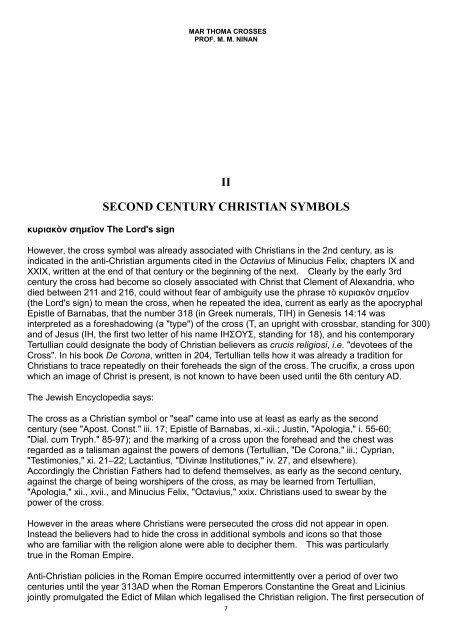marthomacross
Create successful ePaper yourself
Turn your PDF publications into a flip-book with our unique Google optimized e-Paper software.
MAR THOMA CROSSES<br />
PROF. M. M. NINAN<br />
κυριακὸν σημεῖον The Lord's sign<br />
II<br />
SECOND CENTURY CHRISTIAN SYMBOLS<br />
However, the cross symbol was already associated with Christians in the 2nd century, as is<br />
indicated in the anti-Christian arguments cited in the Octavius of Minucius Felix, chapters IX and<br />
XXIX, written at the end of that century or the beginning of the next. Clearly by the early 3rd<br />
century the cross had become so closely associated with Christ that Clement of Alexandria, who<br />
died between 211 and 216, could without fear of ambiguity use the phrase τὸ κυριακὸν σημεῖον<br />
(the Lord's sign) to mean the cross, when he repeated the idea, current as early as the apocryphal<br />
Epistle of Barnabas, that the number 318 (in Greek numerals, ΤΙΗ) in Genesis 14:14 was<br />
interpreted as a foreshadowing (a "type") of the cross (T, an upright with crossbar, standing for 300)<br />
and of Jesus (ΙΗ, the first two letter of his name ΙΗΣΟΥΣ, standing for 18), and his contemporary<br />
Tertullian could designate the body of Christian believers as crucis religiosi, i.e. "devotees of the<br />
Cross". In his book De Corona, written in 204, Tertullian tells how it was already a tradition for<br />
Christians to trace repeatedly on their foreheads the sign of the cross. The crucifix, a cross upon<br />
which an image of Christ is present, is not known to have been used until the 6th century AD.<br />
The Jewish Encyclopedia says:<br />
The cross as a Christian symbol or "seal" came into use at least as early as the second<br />
century (see "Apost. Const." iii. 17; Epistle of Barnabas, xi.-xii.; Justin, "Apologia," i. 55-60;<br />
"Dial. cum Tryph." 85-97); and the marking of a cross upon the forehead and the chest was<br />
regarded as a talisman against the powers of demons (Tertullian, "De Corona," iii.; Cyprian,<br />
"Testimonies," xi. 21–22; Lactantius, "Divinæ Institutiones," iv. 27, and elsewhere).<br />
Accordingly the Christian Fathers had to defend themselves, as early as the second century,<br />
against the charge of being worshipers of the cross, as may be learned from Tertullian,<br />
"Apologia," xii., xvii., and Minucius Felix, "Octavius," xxix. Christians used to swear by the<br />
power of the cross.<br />
However in the areas where Christians were persecuted the cross did not appear in open.<br />
Instead the believers had to hide the cross in additional symbols and icons so that those<br />
who are familiar with the religion alone were able to decipher them. This was particularly<br />
true in the Roman Empire.<br />
Anti-Christian policies in the Roman Empire occurred intermittently over a period of over two<br />
centuries until the year 313AD when the Roman Emperors Constantine the Great and Licinius<br />
jointly promulgated the Edict of Milan which legalised the Christian religion. The first persecution of<br />
7


















